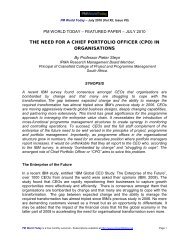Information Measurement Theory (IMT) - Performance Based ...
Information Measurement Theory (IMT) - Performance Based ...
Information Measurement Theory (IMT) - Performance Based ...
You also want an ePaper? Increase the reach of your titles
YUMPU automatically turns print PDFs into web optimized ePapers that Google loves.
CHAPTER 2: INFORMATION MEASUREMENT THEORY (<strong>IMT</strong>)<br />
This can be deduced using the following assumptions:<br />
1. A person can be defined by a combination of factors and measurements.<br />
2. The person‟s environment can be defined by the same combination of factors and<br />
measurements.<br />
3. The person‟s environment, the person, and the description of the environment are<br />
three different views of the same event.<br />
4. Every point in time is at equilibrium.<br />
5. Every location in time where an individual is located has a perceived amount of a<br />
level of information as defined by Figure 2.4.<br />
<strong>IMT</strong> does not address the “which-came-first-the-chicken-or-the-egg” argument. The<br />
environment describes the person or entity, and the environment cannot be described<br />
without the person. There is no differential between the measurements of an entity<br />
and the environment of the entity at a particular location and at a specific point in<br />
time. Therefore, the environment or event is the person.<br />
Every person possesses a unique level of perception and information (Hawking 1988).<br />
The restriction here is not whether the information exists, but the individual‟s ability to<br />
perceive and their processing speed. <strong>IMT</strong> identifies differentials (criteria) between<br />
individuals. No two individuals have the same combination of measurements. Table 2-<br />
1 is an example of the differences between two people.<br />
The combined values for all of the different factors create an individual‟s unique<br />
identity. Each of the aforementioned factors has a relationship to the level of<br />
perceived information, the ability to process information, and the opportunity to<br />
access information. Therefore, all characteristics are relative and somehow related to<br />
information.<br />
CRITERIA INDIVIDUAL 1 INDIVIDUAL 2<br />
Education level: 21 Years 13 Years<br />
Financial status: $100K/Year $27K/Year<br />
Location: North America Asia<br />
Time of birth: 5/5/1965 5/5/1950<br />
Type of government in environment: Democracy Communism<br />
Family size: 8 2<br />
Birth order: Last First<br />
Genetic makeup: Unique Unique<br />
Occupation type: Engineer Farmer<br />
Table 2-1: Differences in Individuals<br />
© Dean Kashiwagi 2010 - 2 - 8





